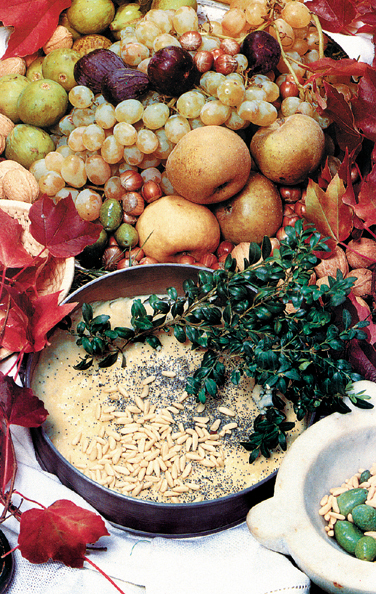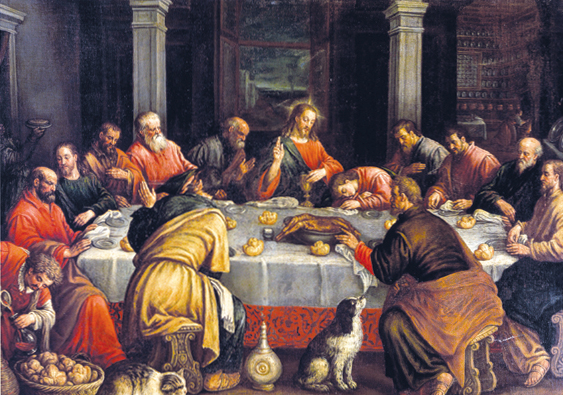
In Jerusalem around 30 C.E., an itinerant Jewish rabbi named Jesus lifted a cup of wine, passed it to his disciples and said:
This is my blood of the covenant, which is poured out for many. Truly I tell you, I will never again drink the fruit of the vine until that day when I drink it new in the kingdom of God (Mark 14:23–25//Matthew 26:27–29).
But exactly what wine was in his cup at the Last Supper? What wine did Jews, during and after the time of Jesus, drink during Passover? And what communion wine did early Near Eastern Christians drink after they had been converted to Christianity by Paul?
Ancient literary sources and recent archaeological finds in Turkey and Israel suggest an answer: The fruit of the vine used in these rituals may well have been a rich, sweet raisin wine, called passum by the Romans.
In both ancient and recent Jewish tradition, raisin wine has been used in Passover celebrations.1 The Talmud not only mentions raisin wine (zimmukin) but also refers to specific kinds, such as ilyaston and enogeron.2 According to the three Synoptic gospels (Mark, Matthew and Luke),a the Last Supper was a Passover supper—meaning that Jesus and his disciples would have been drinking wine used in Jewish ritual: possibly passum.
The sweet passum was produced in Rough Cilicia (so-called because of the jagged landscape of western Cilicia), on the Mediterranean coast of southern Turkey,b and shipped in a small, locally produced vessel known as the “Pinched-handle” amphora (see photos of amphora). These amphoras have a short cylindrical neck ending in a rounded rim, with two small handles looping from just below the rim down to the shoulder. The turn of the handle is pinched in on both sides (thus the name “Pinched-handle” amphora) to form a finger hold. Such amphoras frequently have a distinctively phalliform toe, unusual in this period though common in Roman amphoras from earlier Roman times. In recent years, a number of Pinched-handle amphoras have been found in Israel: at Shiqmona, Jaffa, Hadera, Jerusalem and Caesarea, as well as off the coast of Atlit. Pinched-handle amphoras are regularly referred to as Zemer Type 41 amphoras—after the typology developed by Israeli archaeologist Avshalom Zemer, who identified the type from remains found in Israel.3
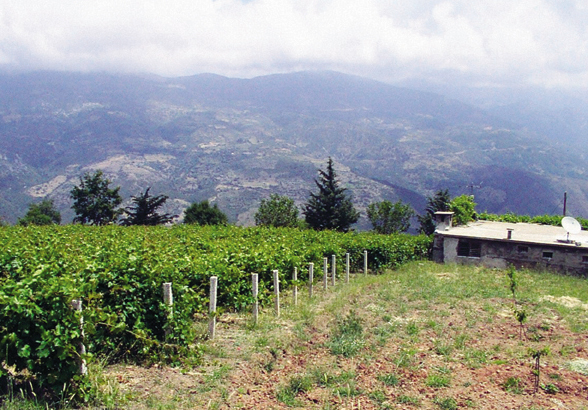
Raisin wine differs from the usual grape wine in that it was made from dried grapes, rather than from the juice of fresh grapes. Once the grapes were ripe, they were generally left on the vine for a few days to dry in the sun, until they shriveled to half their size. In a treatise on agriculture, the first-century C.E. Roman Spaniard Columella noted that this process increased the grapes’ sugars and tannins (a natural preservative) so that the resulting wine had a higher alcohol content and greater longevity (De Re Rustica 27.1, 39.1). In another procedure, the grapes were picked when ripe and spread out on trays under the sun, or sometimes immersed in boiling olive oil. Pliny the Elder (23–79 C.E.), who especially praised the passum from Rough Cilicia (along with the raisin wines from Crete and Africa), wrote that the dried fruit was soaked in a good wine until the berries became swollen; then they were crushed underfoot and pressed into an even superior wine (Natural History 14.81–82). A bulk-grade passum could also be made by adding water for a second pressing.
Today, raisins are the leading export crop of Turkey, though only 20 of the thousand grape varietals grown there are appropriate for viniculture, and only two percent of the grape crop actually goes into wine making in this Islamic nation. Both wild and cultivated grapes are found throughout Rough Cilicia. Ancient sources describe Cilician raisins as golden yellow in color, much like the raisins available in the vegetable and fruit bazaars in such southern Turkish cities as Alanya and Gazipasha.4
According to a Roman proverb, “The drier the grapes the stronger the passum.” In producing wine, the most essential factor is the concentration of the grape’s sugars (know as the “Brix,” named after the 19th-century German inventor A.F.W. Brix). A high Brix content is determined by soil conditions and the amount of water and sunlight the vine receives during a crucial period late in the growing season. Rough Cilicia, it turns out, has an optimal climate for growing very sweet grapes. Its limestone slopes and porous earth allow for excellent drainage, and the region gets plenty of rain early in the growing season and then a succession of hot sunny days toward the end (July and August), as the grapes ripen. The result: lots of sugar for fermentation, and lots of tannins to keep this strong, sweet, heady wine long-lived.
A sixth-century B.C.E. Phoenician inscription found in Cilicia mentions the particularly high quality of locally produced wine—though it does not identify the kind of wine. Roman sources from the second century B.C.E., such as Cato the Elder, specifically mention passum, and thereafter raisin wines from Cilicia, Crete and Africa are referred to by various sources.
The archaeological evidence of recent years also suggests that passum production in Cilicia took place mainly from the first to the fourth century C.E. Not only have numerous locally produced amphora remains been found in association with press installations, but archaeologists are increasingly finding evidence of kilns. In 1989 Caroline Williams, an archaeologist with the Canadian excavations at the Cilician site of Anemurium, reported the first evidence of an ancient kiln used to fire Pinched-handle amphoras—the vessels now known to have been used specifically to ship passum.5
The name “Pinched-handle” amphora was coined by John Lund of the Copenhagen National Museum, who has called attention to the significant distribution of Pinched-handle amphoras in western Cyprus and, with J.W. Hayes, has proposed a Cypriot origin for the type. No Cypriot kiln sites, however, have been found.6 New evidence recovered by the Rough Cilicia Archaeological Survey team indicates that the Pinched-handle amphora (along with other kinds of earthenware) was produced at several points along the coast of western Rough Cilicia.c The remains of one likely kiln site, probably in operation during the third century C.E., lie on a beach near the mouth of a small river a few miles south of the ancient city of Syedra.
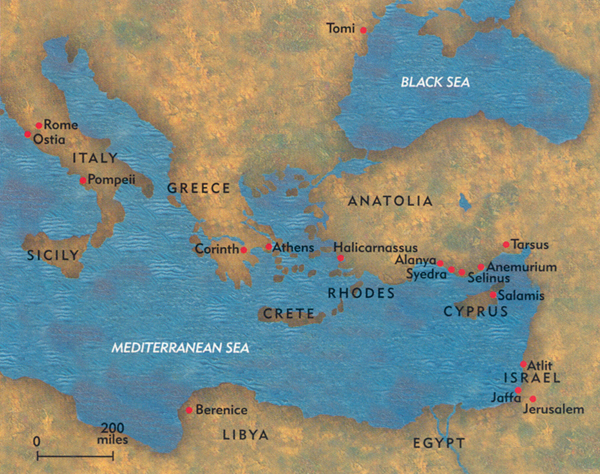
During the 1996 survey season a second site was discovered in the vicinity of Selinus, a little more than a mile north of the modern town of Gazipasha, near the mouth of the Biçkici River. To find it, one must turn off the highway for about a mile on a dirt road that ends near the base of a small coastal mountain. In a field near the mouth of the river, directly before a large freestanding Roman tower, the team encountered a dense concentration of amphora and other sherds. Although no actual kilns have been found, the evidence supporting this site’s identification as a kiln includes partly vitrified kiln-lining fragments and several small vitrified pieces that were misfired, such as an amphora toe with a small square tile of fired clay (probably used to help rest the jar on the kiln floor) melted against it.
Yet another ancient kiln may have stood in the town of Antiochia ad Cragum. The site lies in a small field, directly beside a modern school. Here the survey team found similar misfired pieces and sherds of Pinched-handle amphoras. In this instance, a number of dressed stone blocks piled up by farmers indicates the likely presence of ancient structures.
Several other sites are now being investigated. The amphoras from each kiln site exhibit distinctive features, showing slight differences in shape, color and material. We can identify Pinched-handle amphoras made at Anemurium, Syedra, Biçkici and, possibly, Antiochia ad Cragum by examining their form and testing their clay. But a number of amphoras show marked differences in clay and slight differences in shape from finds at the sites identified so far. These may have been manufactured at the sites now being investigated.
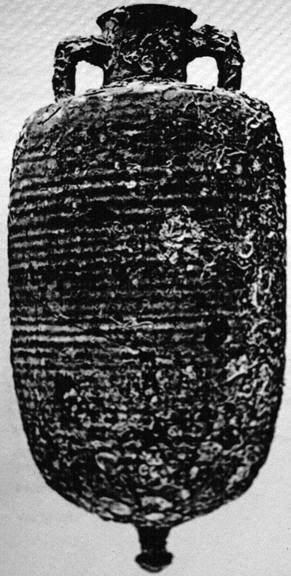
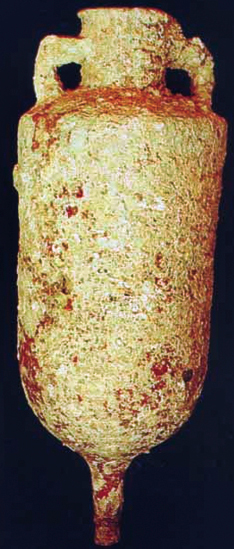
Pinched-handle amphoras have turned up at Halicarnassus (modern Bodrum, Turkey), Cyprus, Tomi (on the western coast of the Black Sea), Athens, Corinth, Ostia, Pompeii, Berenice (modern Bengazi, Libya), Israel, Gaza, Egypt, the Sudan, the Gulf of Fos (off Marseilles, France) and elsewhere.7 With its oddly squeezed handles, deeply ridged body, broad shoulders and long phalliform toe, its designers and producers apparently sought to distinguish this Rough Cilician amphora from the other earthenware shipping vessels circulating in the Mediterranean. Over the centuries, despite minor variations in material and form, the Pinched-handle amphora remained surprisingly uniform in design—even though they were manufactured at a number of sites in Cilicia and possibly even in Cyprus (though, as we have noted, no Cypriot kiln sites have been found).
Throughout the Roman world, it seems, people liked their passum. According to De Re Coquinaria (On Cooking), the early imperial gourmet cookbook of Apicius (a possibly legendary figure under whose name a group of recipes was collected in the fifth century C.E.), raisin wine was essential as a cooking wine, especially in making stews, vegetable sauces and desserts.8 The rich, fragrant passum was also served as a dessert wine.
Perhaps the real reason we find such far-flung evidence of passum consumption, however, is that it was readily available to women. In The Learned Banquet (228 C.E.), the Greek-Egyptian writer Athenaeus comments on a passage in the historical writings of Polybius (second century B.C.E.): “Among the Romans, as Polybius says in his fifth book, women were forbidden to drink wine. But they drink the so-called passum. This is made from the raisin, and, when it is drunk, tastes very much like the sweet wine of Aigosthena [Greece] and Cretan wine.”9 Many sources refer to prohibitions against women drinking wine and even entering household wine cellars. These references, however, are mostly antiquarian in nature—that is, they describe social conditions that prevailed much earlier in Rome. For example, Pliny the Elder quotes Cato the Elder (234–149 B.C.E.) in saying that Roman women with wine on their breath had to beware of exposure through the ius osculi, the requirement that they greet male relatives (which for married women would have meant their in-laws) every morning with a kiss (Natural History 14:90).
According to Athenaeus, rebellious Roman women who were determined to drink wine evaded detection by indulging in passum consumption. For one thing, this wine was commonly found in Roman kitchens and thus readily accessible to women. The second-century C.E. writer Aulus Gellius, also quoting the elder Cato, observed that the raisin wine’s sweet taste formed part of its attraction for women (Attic Nights 10.23.1). He also noted that passum left no scent on one’s breath, enabling female consumers to evade detection while performing the ius osculi. Owing to its long shelf life, moreover, passum containers could be repeatedly opened and resealed, and the wine could be stored in decanters. This further enhanced the likelihood of undetectable consumption by Roman women.
Thus it appears that the most severe prohibitions against female drinking in Rome had become considerably weakened or had been abolished by this time. Perhaps it was simply impossible to stop women from drinking passum, or perhaps the prohibition fell into disuse as a result of a general increase in the consumption of wine by both men and women.
In his De Re Rustica, Columella describes a number of uses for passum in animal husbandry. (Columella’s source in these passages was a lost agricultural treatise written by Mago the Carthaginian in Punic in the third century B.C.E.) Columella advises farmers to use passum to treat the swollen knees of oxen (De Re Rustica 6.12.4) by placing a plaster made of yeast, barley flour and passum on the sore joints. He also describes several applications for passum in beekeeping—controlling bellicose bees by sprinkling them with passum (9.9.6), restoring strength to sick bees by feeding them passum (9.13.7), and sustaining an entire beehive population through the winter by repeatedly soaking wool with passum and placing it at the hive entrance (9.14.15). According to Columella, the uvae passae (the raisins from which passum was made), when sprinkled with water, provided good nutrition for bees. Some two centuries earlier, in the early second century B.C.E., Cato the Elder wrote that uvae passae were tasty food for human beings, too, and that an adequate supply should be kept in every housekeeper’s pantry (De Agri Cultura 143).
The frequent remains of Cilician Pinched-handle amphoras in Israel indicate that it was widely consumed throughout the Holy Land. This conforms with Hebrew records mentioning the use of zimmukin, or raisin wine, in Jewish rituals. Passum has certain properties that would lend it to ritual use—such as a long shelf life (for storage between celebrations) and high alcohol content (for the slight tipsiness generally preferred in religious rituals). It was also a “civilized” imported wine, appropriate for special occasions.
Although Jewish dietary laws would have prohibited the consumption of wine made by Gentiles,d passum may have been used for ritual purposes by less strictly observant Jews. Another possibility is that wine producers in Rough Cilicia were aware of these restrictions and made certain that some portion of the vintage met “kosher” requirements. Or possibly Cilician Jews themselves produced and exported passum to Israel. We know of at least one tomb inscription, from Selinus in Rough Cilicia, of a Jewish man named Iose Theoudion who was probably a prominent landholder or merchant.10
Early Christians, many of them Christian Jews, may well have inherited the use of raisin wine from Jewish liturgy. For non-Jewish Christians (and for Greeks, Romans and others living in Palestine), the dietary laws would not have been an issue. Nor do early Christians appear to have been opposed to women’s drinking. Clement of Alexandria (c. 150–215 C.E.), a theologian and Father of the early church, did rail against excessive drinking: “A drunken woman is a cause for anger, says the Bible, since a woman who debauches herself in drink is a source of irritation to God. Why? Because such a woman does not hide her shamelessness.” But he seems less concerned with drinking itself than with the consequences of drinking: Inebriated women become intoxicated with pride and cannot restrain themselves from engaging in debauchery.11
The remains of early Cilician Christian churches, chapels and tombs typically have Pinched-handle amphoras among their remains. St. Paul himself, born in the Cilician town of Tarsus, traveled extensively through this region and would have known the wine well. It is tantalizing to speculate that the early Christian congregations of Rough Cilicia used Cilician passum in their communion services—though we have no proof of it.
During the economically unstable years of the early Roman Empire, when wine production in Italy declined, Cilician passum—along with Cretan passum and other wines from the Roman provinces—found its niche in the market, a niche it continued to fill for several centuries. The discovery of the importance of passum exports from Cilicia has also filled a large gap in modern scholarship. Recently, in preparing a history of Roman trade, Elizabeth Lyding Will was unable to characterize the exports from Cilicia. Now the research by Nicholas K. Rauh and the Rough Cilicia Archaeological Survey Project, as well as by Caroline Williams at Anemurium, shows that the principal export was raisin wine.
Economically and gastronomically, passum was the eastern Mediterranean’s answer to the salty fermented fish sauces, such as garum, produced in the western Mediterranean. Without the neutralizing sweetness of passum, garum might never have achieved its heralded place on the Roman palate. And, perhaps, without the saltiness of garum, passum might never have appeared in Jesus’ cup, if it did.
MLA Citation
Footnotes
In the Gospel of John, the seven-day Passover festival does not begin until after Jesus is crucified, ruling out the possibility that the Last Supper was a Passover ritual.
Cilicia was not the only source of passum, but the raisin wines produced in Cilicia, on Crete and in North Africa were considered the best varieties. Recent research has shown that that Cilician passum was shipped in Pinched-handle (Zemer Type 41) amphoras. Cretan passum was shipped in a differently shaped vessel (see Antigone Marangou-Lerat, Le vin et les amphores de Crète, Ètudes Crétoises 30 [Athens: Ècole Française d’Athènes, 1995], Type AC1). The kind of vessel used to ship African passum has not yet been identified.
Those seeking further information about the Rough Cilicia Archaeological Survey Project may visit its Web site at http://pasture.ecn.purdue.edu/~rauhn/.
At least by the early rabbinic period (second century C.E.), wine made or bottled by Gentiles was forbidden to strictly observant Jews. So severe was the interdiction against the drinking of non-Jewish wine that even wine in a container accidentally touched by a Gentile was prohibited. There were several exceptions, however, such as boiled wine and certain wines with honey or spices. Perhaps the rich, sweet passum was also excepted.
Endnotes
Although recent scholarship suggests that the Seder did not formally become part of the Passover celebration until after the destruction of the Temple in 70 C.E., important rituals invariably evolve from long-standing cultural practice. See Jonathan Klawans, “Was Jesus’ Last Supper a Seder?” Bible Review, October 2001; B. Bokser, The Origins of the Seder: The Passover Rite and Early Rabbinic Judaism (Berkeley: University of Cailfornia, 1984); and Eliezer Segal, “The Seder as a Living Tradition,” Jewish Star (Calgary, Canada), March 11, 1988.
See Halaka-Yomi 49: 1–14, “The Blessings for Wine”; and Encyclopedia Judaica, “Wine.” A wine called oenogarum (“wine-garum”), a word clearly related to the Hebrew enogeron, was produced elsewhere in the Roman world; the Roman gourmet Apicius advises readers to use oenogarum to counteract the saltiness of garum.
See Avshalom Zemer, Storage Jars in Ancient Sea Trade(Haifa: National Maritime Museum Foundation, 1977), pp. 52–54.
Not all of the grapes cultivated in the classical period were used to make wine. In De Re Rustica, for instance, Columella mentions Rhodian grapes as among the best for eating.
Caroline Williams, Anemurium: The Roman and early Byzantine pottery (Toronto: Subsidia Mediaevalia 16, 1989), p. 94.
See John Lund, “The ‘Pinched-handle’ Transport Amphorae as Evidence of the Wine Trade of Roman Cyprus,” Praktika tou Tritou Diethnous Kyprologikou Synedriou (Lefkosia, 16–20 April, 1996), vol. 1: Archaion Tmema (Lefkosia, Cyprus: Etaireia Kypriakon Spoudon, 2000), pp. 565–578; and J.W. Hayes, Paphos III: The Hellenistic and Roman Pottery (Nicosia: Department of Antiquities, Cyprus, 1991), p. 91 (Type III).
Lund assembles the evidence for the distribution of Pinched-handle amphoras in “The ‘Pinched-handle’ Transport Amphorae,” pp. 570–571. For the neck fragment from the Gulf of Fos, see Martine Sciallano and Patricia Sibella, Amphores: Comment les identifier? (Aix-en-Provence: Èdisud).
See the translation of Apicius by John Edwards, The Roman Cookery of Apicius (Washington, DC: Hartley and Marks, 1984), which includes discussion of passum. A more recent adaptation of Apicius also includes frequent references to passum: Ilaria Gozzini Giacosa, A Taste of Ancient Rome (Chicago and London: University of Chicago, 1992).
On Athenaeus’s quotation from Polybius and the drinking of passum by women, see F.W. Walbank, A Historical Commentary on Polybius (Oxford: Clarendon, 1957), vol. 1, pp. 671–672.
See G.E. Bean and T.M. Mitford, “Sites Old and New in Rough Cilicia,” Anatolian Studies 12 (1962), p. 206, no. 30.


